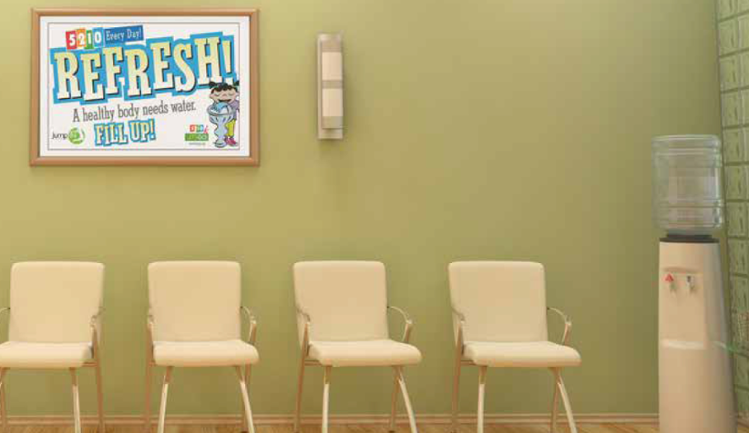How can healthcare providers help prevent childhood obesity?
Families look to their healthcare providers for trusted health advice, especially when sorting through the noise of social media where health messages can be confusing and contradictory. But time is short at a wellness visit—with lots of topics to cover—and conversations about weight can be challenging for doctors and patients alike. So what can a healthcare practice do?

Focus on healthy behaviors
Help families remember what’s “healthy” by promoting the nationally recognized, evidence-based 5-2-1-0 goals:
- Eat 5 or more servings of fruits and vegetables per day
- Limit screen time to 2 hours or less daily
- Get at least 1 hour of physical activity
- Drink 0 sugary beverages and more water
Hearing the 5-2-1-0 message at the doctor’s office is consistent with health messages children are hearing at school and child care. This, in turn, helps keep good choices top of mind and more likely to become habit.
Additionally, focusing on 5-2-1-0 puts healthy behavior for all children at the forefront of your practice, rather than singling out overweight individuals and focusing on the negative. Consider incorporating the 5-2-1-0 Healthy Habits Questionnaire into your office work flow.
Engage the whole team
It’s important to engage not only the medical and nursing staff but also the administrative staff in your healthy families initiatives. Help everyone brainstorm and implement ways to role model healthy choices for families. Acknowledge that staff may have their own attitudes and beliefs around healthy behaviors and weight issues. Reinforce that this can be an uncomfortable topic, filled with culturally sensitive behaviors, emotions, and opinions. Help staff reflect on their own experiences working with patients and families around healthy behaviors and weight issues.
Assess your environment
Is your office promoting positive, healthy behaviors and attitudes about weight—for patients and staff? Try these:

- Add 5-2-1-0 posters to your waiting room and all exam rooms
- Role model by wearing a pedometer, drinking water, scheduling walking meetings
- Serve healthy lunches at staff meetings and be conscious of snacks and drinks that are visible to patients and families
Screen and document body mass index (BMI)
Measuring BMI percentile for age/gender is a good screening tool to identify children who may have an increased percentage of body fat.
Check it out: A variety of presentations and handouts from esteemed experts are available in our CME Workshop Archive.
Choose language intentionally
You may need to think differently about how you talk with patients and families when counseling them. They may not necessarily need more information but perhaps need help defining their own health goals and willingness to change.
The language you use is very important when working with patients and families. Be sure to focus on positive, healthy behaviors rather than weight. Motivational interviewing (MI) is a useful tool when engaging in conversations.
Distribute tools one at a time
It is easy for patients and families to feel overwhelmed by too much information or lifestyle changes. Setting small, achievable goals is most effective. Distribute handouts and educational materials one at a time based upon the patient’s and family’s areas of interest.
We’ve compiled a set of 5-2-1-0 family materials ideal for healthcare providers. You can find even more in our robust Resource Hub. As a team, decide the following:
- Which handouts are you going to use?
- Where will the 5-2-1-0 handouts be stored/displayed in your office?
- Who is responsible for printing/restocking handouts?
Incorporate healthy 5-2-1-0 messaging in your marketing efforts
Showcase your practice’s commitment to positive, healthy behavior by placing 5-2-1-0 messages on your website or social media communications. Get started with our 52 Ready-to-Use Wellness Messages.
Ready for more?
Helping patients prevent obesity starts by ensuring that your office is a healthy place for employees and their families. Check out our overview to workplace wellness to see what improvements you might make in your healthcare practice. Download the guide.

Topics: Clinician Engagement
Subscribe for more
Want more ideas for healthy schools, workplaces, child care providers, and families? Subscribe to our blog for weekly tips delivered right to your inbox!
Reduce screen time to improve children's health and development NEXT »
What is healthy? 4 steps anyone can take.
